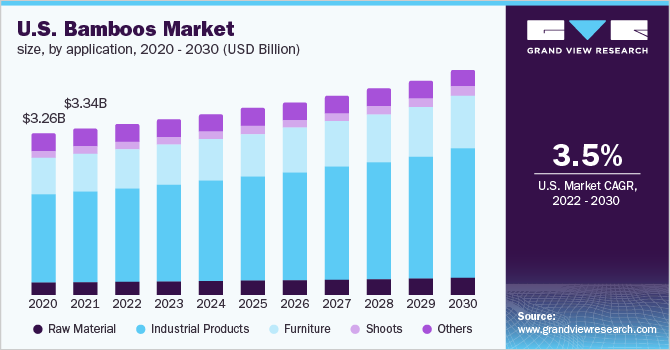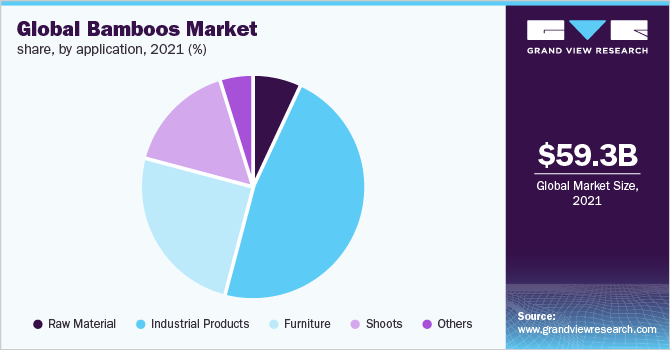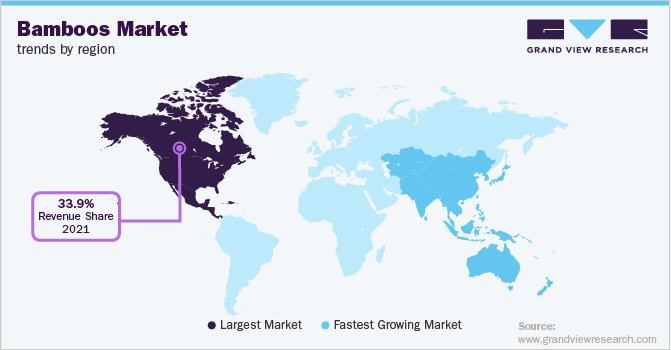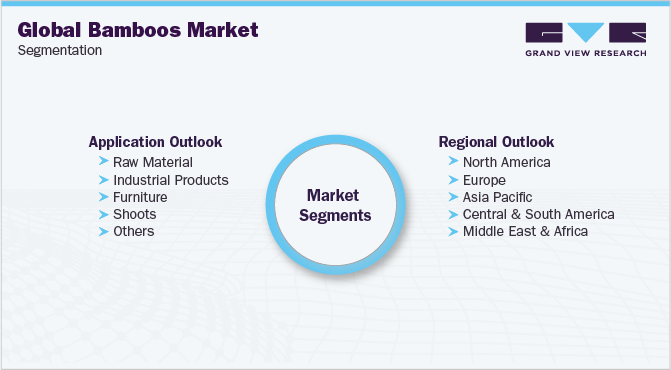- Home
- »
- Advanced Interior Materials
- »
-
Global Bamboos Market Size & Share Report, 2022-2030GVR Report cover
![Bamboos Market Size, Share & Trends Report]()
Bamboos Market Size, Share & Trends Analysis Report By Application (Raw Material, Industrial Products, Furniture, Shoots), By Region (North America, Europe, Asia Pacific, Middle East & Africa, Central & South America), And Segment Forecasts, 2022 - 2030
- Report ID: GVR-2-68038-819-0
- Number of Report Pages: 90
- Format: PDF, Horizon Databook
- Historical Range: 2017 - 2020
- Forecast Period: 2022 - 2030
- Industry: Advanced Materials
Report Overview
The global bamboos market size was estimated at USD 59.30 billion in 2021 and is expected to expand at a compound annual growth rate (CAGR) of 4.5% from 2022 to 2030. The growth of the global industry is expected to be driven by the growing investments in infrastructure development and the rising consumer awareness about sustainable, durable, and eco-friendly products.

The COVID-19 pandemic disrupted the global market and bought it to a standstill. The supply, cultivation patterns, and peak harvesting seasons were all disrupted over an entire production cycle. The cultivators, suppliers, manufacturers, and the middlemen involved in the industry all suffered the impact, and many related small-scale businesses were destroyed over the period of COVID-19. Due to the large-scale migration of labor forces during the COVID-19 period, bamboo cultivations and plantations were left unattended, which resulted in the loss of harvest around different regions of the world.
The U.S. is expected to witness the fastest growth in North America on account of the growing demand for industrial products coupled with the launch of innovative bamboo products. The U.S. is expected to remain a major consumer in the industry owing to the rising product demand from various end-use industries. The rising concerns about the environment and reducing carbon emissions encourage consumers to opt for sustainable products specially made from bamboo, which is expected to increase bamboo cultivation and add growth prospects to the U.S.
Bamboos are widely used as a replacement for conventional materials, including wood for furniture, hardwood for flooring and decking, plastic in everyday items, such as toothbrushes, charcoal production, medicinal products, and bamboo fiber, to replace cotton & synthetic fabrics. The cost of bamboo cultivation is low, and the time required for bamboo to grow to its full potential is also very less than compared to other hardwoods.
Skilled labor is necessary for the conversion of bamboo into usable resources. The biggest issue facing the bamboo industry is the lack of skilled workers since the industry is highly reliant on manpower. There are more than 1000 species of bamboo around the world and efficiently using these species would help in the better utilization of bamboo resources. A skilled labor force is expected to improve production capacities, increase productivity, save money, and enhance the scope of innovation in the industry.
The bamboo products are distributed with the help of offline and online channels in domestic and international markets. The industry players sell the products through their websites directly with the help of their distribution network, whereas major companies have regional offices to serve their customers with personalized products, and small-scale manufacturers generally distribute their products directly to consumers via third-party e-commerce portals.
Application Insights
The furniture application segment in the bamboo market accounted for the second largest revenue share of 25.7% in 2021. It is expected to expand at a CAGR of 4.4% in terms of revenue during the forecast period. This is due to increased global demand for woven and crocheted furniture owing to its durability, easy availability, and high tensile strength. Additionally, it is a wood substitute and has the same appearance as wood which is driving the demand for bamboo in furniture applications.
Bamboo raw materials comprise timber substitutes, scaffolding, and bamboo poles. The demand for residential construction is surging significantly worldwide owing to ongoing urbanization and the increasing population. This has led to a rise in the number of construction projects. The rise in construction activities worldwide is projected to contribute to the growth of the raw materials segment during the forecast period.

The industrial application segment led the industry and accounted for about USD 23.61 billion. It is anticipated to expand at the highest CAGR of over 5.0% during the forecast period. The segment is projected to witness significant growth compared to raw materials, furniture, and shoot application segments owing to the surge in demand for paper and board packaging products due to the flourishing e-commerce sector across the world.
The shoots segment is projected to grow significantly during the forecast period owing to increasing demand for edible bamboo and rising bamboo cultivation worldwide. Moreover, the rising awareness among the consumers about the potential of bamboo shoots for use as a healthy edible in their diet as they contain amino acids, proteins, vitamin A, vitamin B6, vitamin E, niacin, and thiamine is further expected to lead to the growth of shoots segment.
Regional Insights
North America accounted for 33.9% of the global revenue share in 2021. It is expected to witness rapid growth, on account of the growing awareness regarding the uses of bamboo, including its edible shoots and the use of older canes in a variety of applications, including landscaping and residential construction. As more farmers in the region attempt to cultivate bamboo, investment prospects in bamboo are anticipated to increase and thus support industry growth in the coming years.
The Asia Pacific led with the largest revenue share of 78.8% in 2021. It is expected to grow at a CAGR of over 4.0% during the forecast period. The bamboo industry witnessed the fastest growth during the forecast period due to the rising consumer awareness regarding the use of sustainable products, growing investment in infrastructure development, and increasing use of sustainable construction resources.

China is the largest bamboo cultivator in the world as the land is rich in bamboo owing to favorable climatic conditions, the country's tradition of using bamboo products, and the availability of low-cost labor. There are over 800 species of bamboo in China, and it is mostly grown in mountainous areas such as Jiangxi, Fujian, Guangdong, Sichuan, Anhui, and Guangxi.
Central & South America is expected to grow at a CAGR of 2.7% during the forecast period owing to initiatives taken to protect the environment and improve the lives of poor people by creating jobs through bamboo farming and manufacturing bamboo products. Central & South America is rich in bamboo compared to other American regions in terms of diversity and bamboo species. The region has 429 species of bamboo and about 20 genera, which are distributed across the region.
The demand for bamboo is escalating in Europe, as it has observed ever-growing acceptance as a tropical timber replacement. Bamboo plantation in the region is augmenting progressively owing to the rise in demand for bamboo products coupled with favorable growth conditions in Spain, Portugal, Italy, and portions of the Balkans. To increase bamboo production and support the expansion of the regional market, the manufacturers are engaging with bamboo growers in Portugal, France, and Belgium.
Key Companies & Market Share Insights
The industry exhibits the presence of several domestic and international players who are trying to enter into unexplored or less explored markets through mergers and acquisitions. The key market players include MOSO International B.V., Bamboo Australia, Bamboo Village Company Limited, Shanghai Tenbro Bamboo Textile Co., Ltd, and Xiamen HBD Industry & Trade Co., Ltd.
The rising number of applications of bamboo in different industries and changing customer preference for non-plastic products provide a huge opportunity for new entrants in the market. But it is challenging for new companies because they need a strong supply chain. However, the industry does not require high capital investments or technical knowledge, which increases the threat of new players. Some prominent players in the global bamboos market include:
-
MOSO International B.V.
-
Bamboo Australia
-
Bamboo Village Company Limited
-
Shanghai Tenbro Bamboo Textile Co., Ltd
-
Simply Bamboo PTY LTD
-
Xiamen HBD Industry & Trade Co., Ltd
-
dassogroup
-
Smith & Fong
-
ANJI TIANZHEN BAMBOO FLOORING CO. LTD
-
Fujian HeQiChang Bamboo Product Co., Ltd.
Bamboos Market Report Scope
Report Attribute
Details
Market size value in 2022
USD 61.69 billion
Revenue forecast in 2030
USD 88.43 billion
Growth Rate
CAGR of 4.5% from 2022 to 2030
Base year for estimation
2021
Actual estimates/Historical data
2017 - 2020
Forecast period
2022 - 2030
Quantitative units
Revenue in USD million/billion and CAGR from 2021 to 2030
Report coverage
Revenue forecast, company ranking, competitive landscape, growth factors, and trends
Segments covered
Application, region
Regional scope
North America; Europe; Asia Pacific; Central & South America; Middle East & Africa
Country scope
U.S.; Canada; Mexico; Germany; U.K.; France; Italy; Benelux; China; India; Japan; Indonesia; Vietnam; Brazil
Key companies profiled
MOSO International B.V.; Bamboo Australia; Bamboo Village Company Limited; Shanghai Tenbro Bamboo Textile Co., Ltd; Simply Bamboo PTY LTD; Xiamen HBD Industry & Trade Co. Ltd; dassogroup, Smith & Fong, ANJI TIANZHEN BAMBOO FLOORING CO. LTD; Fujian HeQiChang Bamboo Product Co., Ltd.
Customization scope
Free report customization (equivalent up to 8 analysts working days) with purchase. Addition or alteration to country, regional & segment scope.
Pricing and purchase options
Avail customized purchase options to meet your exact research needs. Explore purchase options
Global Bamboos Market Segmentation
This report forecasts revenue growth at global, regional, and country levels and provides an analysis of the latest industry trends in each of the sub-segments from 2017 to 2030. For this study, Grand View Research has segmented the global bamboos market report based on application and region:

-
Application Outlook (Revenue, USD Billion, 2017 - 2030)
-
Raw Material
-
Industrial Products
-
Furniture
-
Shoots
-
Others
-
-
Regional Outlook (Revenue, USD Billion, 2017 - 2030)
-
North America
-
U.S.
-
Canada
-
Mexico
-
-
Europe
-
Germany
-
U.K.
-
France
-
Italy
-
Benelux
-
-
Asia Pacific
-
China
-
India
-
Japan
-
Indonesia
-
Vietnam
-
-
Central & South America
-
Brazil
-
-
Middle East & Africa
-
Frequently Asked Questions About This Report
b. The global bamboos market size was estimated at USD 59.30 billion in 2021 and is expected to reach USD 61.69 billion in 2022.
b. The global bamboos market is expected to grow at a compound annual growth rate of 4.5% from 2021 to 2030 to reach USD 88.43 billion by 2030.
b. The industrial application segment dominated the bamboos market with a share of 39.8% in 2021 due to increasing infrastructure spending worldwide to use sustainable building and construction materials.
b. Some of the key players operating in the bamboos market include MOSO International B.V., Bamboo Australia, Bamboo Village Company Limited, Shanghai Tenbro Bamboo Textile Co., Ltd, Simply Bamboo PTY LTD, Xiamen HBD Industry & Trade Co., Ltd, dassogroup, Smith & Fong, ANJI TIANZHEN BAMBOO FLOORING CO. LTD, Fujian HeQiChang Bamboo Product Co., Ltd.
b. The key factors that are driving the bamboos market include growing investments in infrastructure development and rising consumer awareness for sustainable, durable, and eco-friendly products.
Share this report with your colleague or friend.
![gvr icn]()
NEED A CUSTOM REPORT?
We can customize every report - free of charge - including purchasing stand-alone sections or country-level reports, as well as offer affordable discounts for start-ups & universities. Contact us now
![Certified Icon]()
We are GDPR and CCPA compliant! Your transaction & personal information is safe and secure. For more details, please read our privacy policy.
We are committed towards customer satisfaction, and quality service.
"The quality of research they have done for us has been excellent."





